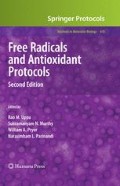Abstract
Oxidative damage to DNA has long been associated with aging and disease, with guanine serving as the primary target for oxidation owing to its low ionization potential. Emerging evidence points to a critical role for sequence context as a determinant of the guanine ionization potential and the associated chemical reactivity of the guanine, as well as the spectrum of damage products that arise from oxidation. Recent studies also suggest that the generally accepted model of oxidation hotspots in runs of guanine bases may not hold for biologically relevant oxidants. One of the primary methods used to address these important problems of sequence context utilizes gel electrophoresis to identify the location and quantity of base damage arising in model oligonucleotides. However, this approach has limited study to those agents that produce few strand breaks arising from deoxyribose oxidation, while ionizing radiation, Fenton chemistry and other biologically relevant oxidants produce sizeable proportions of both base and sugar damage. To this end, we have developed a universal method to quantify sequence context effects on nucleobase damage without interference by strand breaks from deoxyribose oxidation.
Access this chapter
Tax calculation will be finalised at checkout
Purchases are for personal use only
References
De Flora, S., Izzotti, A., Randerath, K., Randerath, E., Bartsch, H., Nair, J., Balansky, R., van Schooten, F., Degan, P., Fronza, G., Walsh, D., and Lewtas, J. (1996) DNA adducts and chronic degenerative disease. Pathogenetic relevance and implications in preventive medicine. Mutat. Res. 366, 197–238.
Migliore, L. and Coppede, F. (2002) Genetic and environmental factors in cancer and neurodegenerative diseases. Mutat. Res. 512, 135–153.
Steenken, S. and Jovanovic, S.V. (1997) How easily oxidizable is DNA? One-electron reduction potentials of adenosine and guanosine radicals in aqueous solution. J. Am. Chem. Soc. 119, 617–618.
Neeley, W.L. and Essigmann, J.M. (2006) Mechanisms of formation, genotoxicity, and mutation of guanine oxidation products. Chem. Res. Toxicol. 19, 491–505.
Henderson, P.T., Jones, D., Hampikian, G., Kan, Y., and Schuster, G.B. (1999) Long-distance charge transport in duplex DNA: the phonon-assisted polaron-like hopping mechanism. Proc. Natl. Acad. Sci. USA 96, 8353–8358.
Hall, D.B., Holmlin, R.E., and Barton, J.K. (1996) Oxidative DNA damage through long-range electron transfer. Nature 383, 731–735.
Saito, I., Nakamura, T., Nakatani, K., Yoshiyoka, Y., Yamaguchi, K., and Sugiama, H. (1998) Mapping of the hot spots for DNA damage by one-electron oxidation: efficacy of GG doublets and GGG triplets as a trap in long-range hole migration. J. Am. Chem. Soc. 120, 12686–12687.
Margolin, Y., Cloutier, J.F., Shafirovich, V., Geacintov, N.E., and Dedon, P.C. (2006) Paradoxical hotspots for guanine oxidation by a chemical mediator of inflammation. Nature Chem. Biol. 2, 365–366.
Margolin, Y., Shafirovich, V., Geacintov, N.E., DeMott, M.S., Dedon, P.C. (2008) DNA sequence context as a determinant of the quantity and chemistry of guanine oxidation produced by hydroxyl radicals and one-electron oxidants. J. Biol. Chem. 283, 35569–35578.
Tretyakova, N.Y., Burney, S., Pamir, B., Wishnok J.S., Dedon, P.C., Wogan, G.N., and Tannenbaum, S.R. (2000) Peroxynitrite-induced DNA damage in the supF gene: correlation with the mutational spectrum. Mutat. Res. 447, 287–303.
Burrows, C.J. and Muller, J.G. (1998) Oxidative nucleobase modifications leading to strand scission. Chem. Rev. 98, 1109–1151.
Sutherland, B.M., Bennett, P.V., Sidorkina, O., and Laval, J. (2000) Clustered damages and total lesions induced in DNA by ionizing radiation: oxidized bases and strand breaks. Biochemistry 39, 8026–8031.
Putney S.D., Benkovic, S.J., and Schimmel P.R. (1981) A DNA fragment with an alpha-phosphorothioate nucleotide at one end is asymmetrically blocked from digestion by exconuclease III and can be replicated in vivo. Proc. Natl. Acad. Sci. USA 78, 7350–7354.
Henner, W.D., Grunberg, S.M., and Haseltine, W.A. (1983) Enzyme action at 3’ termini of ionizing radiation-induced DNA strand breaks. J. Biol. Chem. 258, 15198–15205.
Takeuchi, M., Lillis, R., Demple, B., and Takeshita, M. (1994) Interactions of Escherichia coli Endonuclease IV and Exonuclease III with abasic sites in DNA. J. Biol. Chem. 269, 21907–21914.
Maxam, A. and Gilbert, W. (1980) Sequencing end-labeled DNA with base-specific chemical cleavages. Meth. Enzymol. 65, 499–560.
Author information
Authors and Affiliations
Editor information
Editors and Affiliations
Rights and permissions
Copyright information
© 2010 Humana Press, a part of Springer Science+Business Media, LLC
About this protocol
Cite this protocol
Margolin, Y., Dedon, P.C. (2010). A General Method for Quantifying Sequence Effects on Nucleobase Oxidation in DNA. In: Uppu, R., Murthy, S., Pryor, W., Parinandi, N. (eds) Free Radicals and Antioxidant Protocols. Methods in Molecular Biology, vol 610. Humana Press. https://doi.org/10.1007/978-1-60327-029-8_19
Download citation
DOI: https://doi.org/10.1007/978-1-60327-029-8_19
Published:
Publisher Name: Humana Press
Print ISBN: 978-1-58829-710-5
Online ISBN: 978-1-60327-029-8
eBook Packages: Springer Protocols

